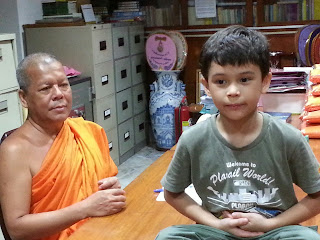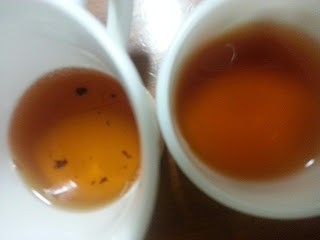I've only reviewed one tisane (herbal tea) here before, coffee leaf tea, but this makes for a great second go at that. This was part of the set of teas and herb teas that my wife's aunt picked up for me on a trip to the North of Thailand, the Chiang Mai area. From here on I'm just going to say "tea" related to it because "tisane" or "herbal infusion" sounds unnatural to keep repeating (but I get it that's it's not really tea). Of course there are some tea purists who would hate to see the word tea used that way, but they wouldn't even click on a post about an herbal tea anyway.
 |
Mulberry leaves |
When I first tried the tea I didn't know what it was, since the tea label was in Thai (it did say the Thai word for mulberry tea, bai hmon, not that I could read that). It didn't look right for tea, but then since I'd just tried two unconventional looking Thai teas I couldn't be sure.
The dried leaf smells like a cross between dried seaweed and toasted sesame, but I guess much nicer than that sounds, warm and earthy and sweet, a clean smell.
The brewed tea / infusion isn't that far from tea made from a tea plant, just not really the same. It has a rich, smooth, slightly sweet, earthy flavor, which comes across much closer to toasted sesame than the seaweed smell. Japanese and Korean people, and Thais to some extent, all eat dried seaweed snacks that are a little different than what washes up on the shore or are used in sushi or miso soup; I want to say better, but of course that's all about preference.
 |
you really could just call them up, dial "66" then drop the "0" |
 |
Mulberry leaf infusion |
Of course one nice thing about a tisane is the forgiving brewing process. The standard approach is hot water, boiling point or very near it, for a longer time, 4 to 5 minutes, but it's not as if anything really ruins the tea. Brewing for less time with cooler water would just result in a lighter tea; letting it sit and sit doesn't ruin it (I tested that once by forgetting it for awhile). The tea is so mellow and smooth even a baby could drink it, which I also tested on my one year old, who liked it. But then I would expect that since she's a fan of lightly oxidized oolongs.
 |
drinking tea, driving a car--they grow up so fast |
Health benefits / places to buy this tea
Tea Village:
One of my favorite tea shops in Thailand, specializing in good teas at reasonable prices. Good is a relative word when it comes to tea; read as quite decent versions but not the highest end rare-tea type, which is a different type of good value that perhaps less people can appreciate. Their assessment:Mulberry Tea is rich in antioxidants, which play a key role in strengthening the immune system and reducing cholesterol levels. Mulberry leaves are rich in vitamins and minerals like calcium, potassium, sodium, magnesium, iron, zinc, vitamins A, B1, B2, C and the amino acids necessary for the body.
Ebay shop (in Spain, might make more sense for Europeans):
An online contact has an herb shop so may as well reference that; this is a tea-bag version. As a loose tea purist (the other kind of tea) tea-bags are sort of the enemy but I guess this kind of thing makes sense for some, and some of the evils of tea-bag camellia sinensis are less likely to apply (I won't even start on all that).As far as cost goes you really pay for someone putting it in bags, and for buying it in the West: these run $20+ (12 pounds) for 120 tea bags, 180 grams of herb, related to about $8.50 for the loose herb in that shop. But then it is in Thailand; you should see what we pay for tropical fruit here.
Related to health claims, from that page:
Its active ingredients are known to promote healthy liver & kidneys, promote proper blood circulation, reduce high blood pressure (hypertension), reduce the effects of hangover and lower blood sugar closely related to diabetes.
That is what you hear here, that it's really good for you. When I hear that about tea--real tea--I'm always thinking "yeah, maybe," but in this case I got it in my head to research it. I must admit I was a bit skeptical of the amino acid claim; that's protein, found in some plants like beans and legumes, but in a leaf?
Nutritional and health claims reviewed
This is about as good a source as one's going to get on nutrition, the related entry for the National Center for Biotechnology Information, U.S. National Library of Medicine:
The results showed that in fresh mulberry leaves the proximate composition values ranged ... from 4.72 to 9.96% for crude protein...
Dang, there it is, protein, the amino acids. And then:
Among vitamins ascorbic acid [C] and beta-carotene [A] were found to range from 160 to 280 mg/100 g and from 10,000 to 14,688 microg/100 g, respectively, in fresh mulberry leave.... The minerals iron, zinc and calcium were observed in the ranges of ...
I know what you are thinking: sure it's great that those are in there--and they missed mentioning a lot of those vitamins in that one claim--but really how do those relate to actual dietary amounts. I'm glad you asked; check this out:
| Nutrient | EAR | RDA/AI | UL[5] | Unit | Top Sources in Common Measures, USDA[6] |
|---|---|---|---|---|---|
| Vitamin A | 625 | 900 | 3000 | µg | turkey and chicken giblets, liver, carrots, pumpkin, sweet potato |
| Vitamin C | 75 | 90 | 2000 | mg | guavas, oranges, grapefruits, frozen peaches, [i] bell peppers |
It messes with your mind trying to map out how this relates to how much someone would brew. The nutritional values are for 100 grams of leaf, but then the tea bags only included a gram and a half. I'll make it easy for roughing out what this means and go with 5 grams, 1/20th that total (probably a little more than I actually brewed loose, but not that much more), and then crunch those numbers.
It all checks out. That sizable dash of leaves would contain most of the Vitamin A you need for the day (kind of crazy, when you think about it), but only around 10% of the C (not bad though). From an herb tea. Of course a dietitian could push on to the next level about absorption rates and other possible problems in this analysis, but lets move on to consider one more point.
Could this really help with diabetes at all, to cite an example of another crazy claim. Sure, or so the American Diabetes Association says related to just one study. One study with limited conclusions is quite far from the fact of the matter but maybe something to at least some of that stuff.
I'll stay skeptical about the miracle-cure super-food style claims but at a glance it probably is really good for you. People should probably drink more real tea anyway. Tons of health claims get thrown around about it too, some of which could be true, and drinking a really good dark-roasted oolong can be a semi-mystical experience.



























